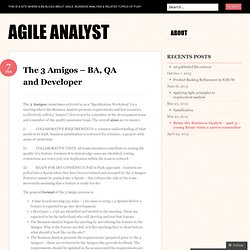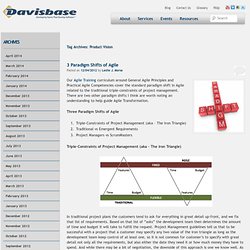

Scrum vs. Kanban: FIGHT! The Non-Existent Software Crisis: Debunking the Chaos Report. The 3 Amigos – BA, QA and Developer. 7 Feb The 3 Amigos (sometimes referred to as a “Specification Workshop”) is a meeting where the Business Analyst presents requirements and test scenarios (collectively called a “feature”) for review by a member of the development team and a member of the quality assurance team.

The overall aims are to ensure: i) COLLABORATIVE REQUIREMENTS: a common understanding of what needs to be built, business justification is conveyed for a feature, a project-wide sense of ownership. ii) COLLABORATIVE TESTS: all teams members contribute to testing the quality of a feature, business & technical edge cases are identifed, testing restrictions are conveyed, test duplication within the team is reduced. iii) READY FOR DEV CONSENSUS: Pull vs Push approach – features are pulled into a Sprint when they have been reviewed and accepted by the 3 Amigos. Swimlane Sizing - Complete & Fast Backlog Estimation. Thanks to Adrian Wible for sharing this tip when I was in Nevada a couple of years ago. It’s now one of the most powerful simple tools I have at my disposal. I use it frequently with teams to rapidly size their backlogs and recalibrate their sizing. This can be used with teams at any experience level but works with least pain if teams used to story points beforehand.
Teams new to story-points (or even working together) often get hung up on the numbers themselves and instinctively want to start converting to hours, ideal days, elapsed days or similar. The value of story points for teams during estimation sessions is in the sizing, not the size. This approach keeps numbers entirely out of the mix until the end and allows participants to focus solely on the relative sizing of stories.
Once we’re over the relative sizing hurdle, adding numbers becomes a straightforward activity. I’ve done this same activity with electronic tools but I’ll describe the manual version here… Preparation: Activity: Product Vision Archives - Davisbase Consulting. Our Agile Training curriculum around General Agile Principles and Practical Agile Competencies cover the standard paradigm shift in Agile related to the traditional triple-constraints of project management.

There are two other paradigm shifts I think are worth noting an understanding to help guide Agile Transformation. Three Paradigm Shifts of Agile Triple-Constraints of Project Management (aka – The Iron Triangle)Traditional vs Emergent RequirementsProject Managers vs ScrumMasters. Www.crosstalkonline.org/storage/issue-archives/2013/201305/201305-Larman.pdf. Definition of Done. Assuming you are on a Scrum/Agile software development team, then one of the first 'working agreements' you have created with your team is a 'Definition of Done' - right?

Oh - you don't have a definition of what aspects a user story that is done will exhibit. Well then, you need to create a list of attributes of a done story. One way to do this would be to Google 'definition of done' ... here let me do that for you: Then you could just use someone else's definition - there DONE! But that would be cheating -- right? It is not the artifact - the list of done criteria, that is important for your team - it is the act of doing it for themselves, it is that shared understanding of having a debate over some of the gray areas that create a true working agreement.
So rather than using someone else's list you want to create your own. Definition of Ready Description.pdf *NEW! Comparing these two charts - what would you say about this team's ability to plan? Agile. Top 100 Agile Books (Edition 2012. Prioritization. Another excellent method for prioritization is Relative Weighting, which Karl Weigers introduced in 1999.

This method not only provides a mechanism for prioritizing requirements based on user input and feedback but also includes the expert judgment of the team. Like Kano and Innovation Games, Relative Weighting allows the product owner to better gauge which features to implement and in what priority order. The first step is to assign a weight to the relative benefit of a feature. A benefit is the advantage for users of having the feature in the final product.
Next is to assign the relative penalty. In the same way, we determine the weight of cost percentage and risk percentage. Now that the weights are set, we ask the users to rate each feature’s relative benefit and relative penalty. For example, let’s say one possible feature is “Make the widget comply with Sarbanes-Oxley regulations.” (Benefit * Weight) + (Penalty * Weight) = Total Value. Estimating. After you’ve chosen your unit of measurement and established your scale, it’s time to estimate.

Most Agile teams use planning poker to estimate the relative size of the stories. It is popular with agile teams because it is an objective measure that includes several subjective estimation techniques, including analogy and expert judgment. The key to planning poker is participation. Everyone on the team needs to participate—yes, everyone. Functional testers will estimate development tasks and vice versa. Start with a set of planning poker cards.
Construction. Requirements.